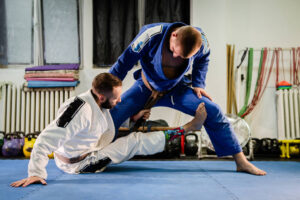In the realm of martial arts, Jitsu Jiu stands out as a captivating and effective discipline that has gained immense popularity in recent years. Originating from Brazil, this martial art form has evolved into a comprehensive system that emphasizes technique, leverage, and strategic thinking. Combining elements of both self-defense and sport, Jitsu Jiu has captured the hearts and minds of practitioners worldwide.

In this article, we will delve into the fascinating world of Jitsu Jiu, exploring its history, principles, training methods, and the numerous benefits it offers.
The Roots of Jitsu Jiu:
Jitsu Jiu finds its roots in traditional Japanese Jiu-Jitsu, which emphasizes the use of leverage and technique to overcome opponents regardless of their size or strength. The founding figure of Jitsu Jiu, Helio Gracie, adapted and refined these techniques to make them accessible to individuals of all body types and physical abilities. This evolution gave birth to Brazilian Jiu-Jitsu (BJJ), the foundation of Jitsu Jiu.
Principles of Jitsu Jiu:
At the core of Jitsu Jiu lies the principle of maximum efficiency and minimum effort. It revolves around the concept that a smaller, weaker individual can defend themselves against a larger, stronger opponent by utilizing proper technique, leverage, and body positioning. Rather than relying on brute force, Jitsu Jiu practitioners focus on controlling their opponents, neutralizing their strength, and applying submissions or joint locks to secure victory.
Training Methods:
Jitsu Jiu training involves a combination of techniques, drills, and sparring sessions. Students begin by learning the fundamental positions, such as the guard, mount, side, and back control. From there, they progress to mastering sweeps, escapes, submissions, and transitions between positions. This progressive approach allows practitioners to develop a solid foundation while gradually expanding their skill set.
Sparring, or “rolling,” is a crucial component of Jitsu Jiu training. It provides practitioners with the opportunity to test their techniques against resisting opponents in a controlled environment. Rolling sessions promote adaptability, problem-solving, and the ability to stay calm and composed under pressure. Additionally, they foster physical fitness, stamina, and mental toughness.

Benefits of Jitsu Jiu:
- Self-defense: Jitsu Jiu equips individuals with practical self-defense skills that can be used in real-life situations. Its emphasis on leverage and technique empowers practitioners to neutralize threats without relying on size or strength.
- Physical fitness: Jitsu Jiu is a physically demanding martial art that engages the entire body. Regular training improves cardiovascular endurance, flexibility, coordination, and core strength. It also helps in weight management and overall fitness.
- Mental well-being: Jitsu Jiu promotes mental discipline, focus, and problem-solving. The complex nature of the art requires practitioners to think strategically and remain calm under pressure. This mental training can positively impact various aspects of life beyond the training mat.
- Stress relief: Engaging in Jitsu Jiu training provides an outlet for stress and tension. The physical activity and the camaraderie among practitioners create a supportive and positive environment, fostering a sense of community and belonging.
- Improved confidence: As practitioners progress and overcome challenges in Jitsu Jiu, their confidence grows. The ability to defend oneself effectively and the sense of accomplishment derived from mastering techniques instill a deep understanding of self-assurance.
The Jitsu Jiu community is renowned for its inclusivity, camaraderie, and mutual respect. Regardless of age, gender, or background, practitioners come together to train, learn, and grow.
Learn more at Wiki as well.
